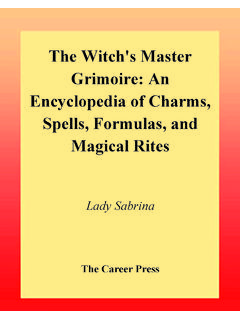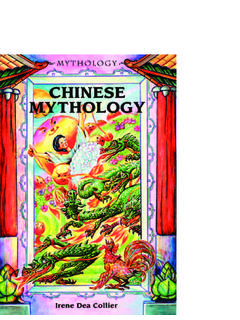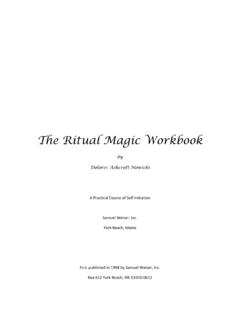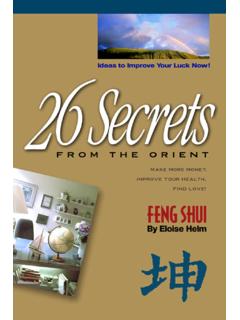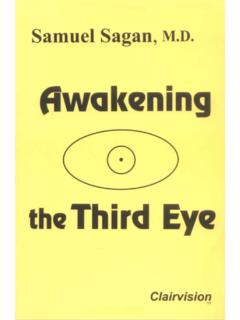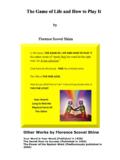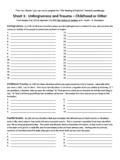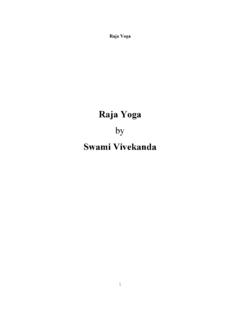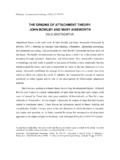Transcription of A Compendium of Information on the Occult Sciences,
1 ACompendium of Information on the Occult Sciences, Magic, Demonology, Superstitions, Spiritism, Mysticism,Metaphysics, Psychical Science, and Parapsychology,with Biographical and BibliographicalNotes and Comprehensive IndexesFIFTH EDITIONIn Two VolumesVOLUME ONEA-LEdited by J. Gordon MeltonJ. Gordon MeltonGale Group StaffJolen Marya Gedridge, EditorChristy Wood, Associate EditorPamela A. Dear, Contributing Associate EditorJason Everett, Contributing Assistant EditorRita Runchock, Managing EditorMary Beth Trimper, Production DirectorEvi Seoud, Production ManagerRita Wimberley, BuyerKenn Zorn, Manager, Production DesignBarbara J. Yarrow, Manager, Imaging and Multimedia ContentTracey Rowens, Senior Art DirectorMichael Logusz, Graphic ArtistDatapage Technologies International, Inc.
2 , TypesettingWhile every effort has been made to ensure the reliability of the Information presented in this publication, Galedoes not guarantee the accuracy of the data contained herein. Gale accepts no payment for listing; and inclusionin the publication of any organization, agency, institutional, publication, service, or individual does not implyendorsement of the editors or publisher. Errors brought to the attention of the publisher and verified to the satis-faction of the publisher will be corrected in future publication is creative work fully protected by all applicable copyright laws, as well as by misappropriation,trade secret, unfair competition and other applicable laws. The authors and editors of this work have added valueto the underlying factual material herein through one or more of the following: unique and original selection,coordination, expression, arrangement, and classification of the rights to the publication will be vigorously 2001 Gale Group, Drake Hills, MI 48331-3535 All rights reserved including the right of reproduction in whole or in part of any 0-8103-8570-8 (Complete Set)ISBN 0-8103-9488-X (Volume 1)ISBN 0-8103-9489-8 (Volume 2)Printed in the United States of America10 9 8 7 6 5 4 3 2 1 VOLUME IIntroduction.
3 ViiEncyclopedia A-L ..1 VOLUME IIEncyclopedia M-Z ..951 Internet Resources ..1713 General Bibliography ..1721 General Index ..1829 ContentsviiThis fifth edition of the Encyclopedia of Occultism & Parapsychology (EOP) continues thetradition established by its predecessors in providing the most comprehensive coverage of thefields of occultism and parapsychology. The first edition, published in 1978, brought togeth-er the texts of two of the standard reference works in the field, Lewis Spence s Encyclopediaof Occultism (1920) and Nandor Fodor s Encyclopedia of Psychic Science (1934). Later, edi-tor Leslie Shepard took on the task of updating their observations and supplementing the vol-ume with new production of this massively ambitious work was sparked by a heightened interest inpsychic phenomena, the Occult , witchcraft, and related topics in the 1970s.
4 This interest,which led directly to the New Age movement of the 1980s, provided a continued wealth ofmaterial for parapsychologists to examine. It also led to a reaction by a group of debunkers toform the Committee for the Scientific Investigation of the Claims of the Paranormal. Thisgroup believed that they were spokesmen for the scientific the TermsThe term Occult remains suspect in many circles. The word derives from Latin and sim-ply means to shut off from view or exposure. However, it eventually came to refer to realitiesspecifically hidden from common sight; the Occult realm is invisible to the physical eye but canbe seen by an inner spiritual vision and/or grasped by psychic intuition.
5 The Occult is theopposite of apocalypse, which means to uncover. The last book of the Christian Bible isalternatively called The Apocalypseor The Revelation. To many religious people, the term occultdenotes that which is opposite of what God has revealed; hence, the realm of Satan and hislegions of demons. Some substance for this observation has been provided by religious lead-ers who combine an exploration of the Occult with open opposition to the more traditionalreligions and religious used in EOP,however, occultism stands for (1) the broad area of human experience(now called extrasensory perception, or ESP) that goes beyond the five senses; (2) the philo-sophical conclusions drawn from consideration of such experiences; and (3) the social struc-tures created by people who have had extrasensory experiences, who attempt to produce andcultivate them, and who believe in their vital significance for human life.
6 Therefore, occultism(or its currently preferred term paranormal ) entails a wide spectrum of experiences fromclairvoyance and telepathy to visions and dreams, from ghost sightings to the pronounce-ments of mediums and channelers. The paranormal encompasses the phenomenon known aspsychokinesis (commonly referred to as mind over matter ) whether in the dramatic formof levitation or teleportation, or in the more commonly experienced phenomenon of spiritu-al healing. It also covers experiences related to death, such as out-of-body travel and Occult also includes a host of techniques and practices originally designed and creat-ed to contact the extrasensory realm. Most frequently associated with the term Occult are thetechniques of magic and divination (including astrology, the tarot, and palmistry).
7 In addi-tion, various forms of meditation, yoga, and psychic development should be included, as wellas some practices more commonly associated with religion, such as speaking in tongues,prayer, and of Occultism & Parapsychology 5th extension, the Occult or paranormal can also legitimately incorporate a legion of mys-terious phenomena not obviously extrasensory in nature: anomalous natural occurrences noteasily understood or explained by contemporary science. Such phenomena as the Loch Nessmonster, unidentified flying objects (UFOs), and Bigfoot, may eventually be attributed to therealm of ordinary sense perception, but their very elusiveness has led them to be associatedwith the Evolution of OccultismThe present-day view of the Occult is highly influenced by the history of the paranormal inthe West during the nineteenth and twentieth centuries.
8 Through the seventeenth century,most people believed in the active operation of Occult (then termed supernatural ) entitiesand forces. This belief brought comfort to some; but, for others, it became a source of fear,leading to suffering, and even death, for many. It allowed some people to rule by their report-ed ability to manipulate supernatural powers, and made it possible for the Inquisition to per-secute thousands as witches and Satanists. It also enabled unscrupulous religious leaders todeceive people with sham relics and the sixteenth and seventeenth centuries, however, there began a serious critique of themore questionable supernatural phenomena, beginning with relics and extending to theactions of the witchfinders.
9 As Protestantism secularized (denied sacred value to) the world,and the acceptance of scientific observation and organization of natural phenomena spread,a general spirit of skepticism was created. In the eighteenth century, this skeptical spirit cre-ated the first significant movement to challenge the role of the supernatural in human socie-ty affirmed the existence of God the Creator, but suggested that God had merely estab-lished a system of natural law, leaving the world to govern itself by that law. By implication,God was divorced from the world, and supernatural events did not occur; rather the super-natural was merely the misobserved natural. Furthermore, neither angels nor spirits com-municated with humans; and, in turn, prayer did not reach God.
10 Religious spokespersonsresponded, of course, and popularized a new definition of miracle the breaking by God ofhis own natural laws to intervene in the lives of his thought was largely confined to a small number of intellectual circles, among themsome very powerful and influential people, including most of the founding fathers of theUnited States Benjamin Franklin, Thomas Jefferson, and George Washington. In the nine-teenth century, the skeptical view of the supernatural became the cornerstone of theFreethought movement. This minority movement impacted every level of intellectual and the-ological thinking at that time. Theologians regularly began their courses with proofs of theexistence of God; preachers debated village atheists; evangelists strengthened their efforts toreach the godless the midst of the debate between traditional religionists and Freethinkers, a few people(known as Spiritualists) proposed a different viewpoint in which the distinction between thislife and the life beyond became a somewhat artificial intellectual construct; everything waspart of one larger natural world.
